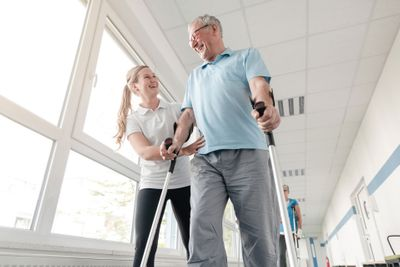Stroke Rehabilitation Occupational Therapy
_______
Stroke is a leading cause of adult disability in the United States, with an estimated 7 million stroke survivors. Each year, approximately 795,000 people have either a new or recurrent stroke. Stroke survivors face multiple challenges, such as weakness on one side of the body, decline in cognitive and emotional functioning, social disability, inability to walk and care for themselves, and a decrease in community participation. At Occupational Therapy Associates, we strive to address these challenges at all stages in the continuum of care, including; acute, sub-acute, chronic, and post-rehab at home and in the community. Occupational Therapists, Maryann, understands that many survivors experience changes in their physical, cognitive, and emotional abilities, which effects being able to independently work, go to school, parent or relax. We proudly offer mobile in-home and virtual care in North Nashville to include the Castalian Springs, Gallatin, Hendersonville, Lebanon and Portland area. Call us at (615) 270-1033 to schedule a time to find solutions that help you conquer obstacles.
Rehabilitation and the Resumption of Participation After a Stroke
The focus of occupational therapy is to help individuals achieve health, well-being, and participation in life through engagement in occupations (i.e., activities). Occupational therapy practitioners collaborate with clients and their families or caregivers to determine what activities are necessary, meaningful, and/or relevant to them. Based on their education and clinical expertise, and the philosophical basis of the profession, occupational therapy practitioners are uniquely able to analyze the interactions among the person, the environments in which they need to function, and the occupations they need or want to perform.
Examples of Occupational Therapy Goals
Depending on the extent of the stroke, the needs and goals of the client, and the phase of stoke recovery, occupational therapy goals and services may include, but are not limited to the following:
Further retraining in self-care skills and adapting tasks or environments (post-rehab), including the appropriate use of adaptive equipment to maximize the ability to perform activities of daily living (ADLs) safely (e.g., bathing, dressing, functional mobility)
Uniquely, we provide oral motor control for aphasia and fine motor coordination.
Addressing ongoing deficits such as weakness, sensory loss, and cognitive or visual impairments that limit engagement in ADLs and instrumental ADLs (IADLS: carrying groceries, cooking a meal, managing money, parenting)
Training in community reintegration and modifying tasks or environments, including, where appropriate, assessment of and training in the use of assistive technology, to maximize independent engagement in IADLs. This includes psychosocial interactions within that community and family life.
Performing work-related task analysis and work site evaluations, and recommending modifications to the workplace; collaborating with educational facilities to facilitate return to school; working with the client on child-care-related tasks and adaptations for safe parenting responsibilities; and recommending adaptations to resume former leisure activities or develop new ones as feasible.

Oral motor control for aphasia.
Developing coping strategies to support psychosocial health and well-being (including relaxation techniques, if appropriate)
Teaching and promoting healthy lifestyle habits and routines to minimize risk of secondary stroke
Developing strategies to overcome barriers to sexual intimacy
Providing pre-driving and driving evaluations, equipment recommendations for safe return to driving, or education on alternate means of transportation
Neuro-Rehabilitation
We are experienced in neuro-rehabilitation to work with people experiencing limitations as a result of an acquired brain injury (Head Injury, Stroke etc.) or a neurological disorder (Multiple Sclerosis, Parkinson’s Disease, Huntington’s Disease etc.). The rehabilitation aims to maximize participation in chosen daily activities such as grocery shopping, dressing, or succeeding in work/ studies. Interventions are goal directed working towards client and family centered outcomes.
